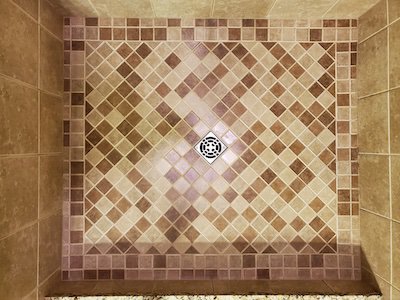

QUESTION
I recently installed a foam shower pan with a linear drain up against the wall. The GC asked me to install metal tile edging around the drain area to “give the tiles a better finish look.” It was pebble tiles. I went to the manufacturer installation guides and couldn’t find any recommendations for using that tile trim in that setup. Now the shower is not draining properly, and they are blaming me for it. I am responsible for it even though I told them that it wasn’t approved by the manufacturer?
The NTCA Technical Team provides information to a contractor who was asked by a GC to install metal edging around a pebble shower floor with linear drain, which is now not draining properly.
ANSWER
After reading your email describing the issue you are having, I can only think of three possible ways the metal edging could prevent the shower from draining properly.
- Improper slope on the shower floor – the TCNA Handbook and ANSI A108 both require a minimum of 1/4" of slope per 12".
- The metal edging was too large – As you know, metal edging comes in many thicknesses. If the metal edging selected was too tall, when adding it around a drain, it would act as a dam preventing the water from draining properly. Also, the bottom of the metal that goes under the tile can slightly raise the height of that tile, potentially affecting the desired slope.
- Low grout joints – It is a very difficult job to grout a pebble shower floor without creating low spots for the water to gather. This, in combinationvwith the metal edging, could create a wet spot close to the drain.
I am not saying that any of these are the issue, but that these are the only things I can come up with for why the metal edging would affect the drainage. A picture of the shower floor, including the drain and metal edging, would be helpful for us to fully understand the problem.
In the meantime, here are a few thoughts that may help guide you:
- As a tile professional, it is important to know that shower floors require a minimum slope of 1/4" per 12", but a lot of jurisdictions will allow up to 1/2" per 12". This extra slope can be very helpful when working with pebble tiles, which have a hard time draining water due to their inconsistency of size and thickness. I would recommend researching local building codes for future projects involving pebbles on shower floors.
- There are currently no industry methods or standards for how to install metal around the perimeter of a line drain. I have also researched the websites of multiple manufacturers of metal edging and cannot find any instructions there either. When we have industry methods, standards, or instructions our job is straightforward, and we rely on those documents to do our job properly. In this case, not having that documentation requires the installation company the added work of contacting the manufacturer seeking their recommendations prior to installation.
- Even though this project is complete I would recommend reaching out to your local rep who may have some helpful advice on how to overcome the issue you are dealing with. If you do not know your local rep please reach back out and I will help connect you.
- I recognize the difficulty of working with pebble tiles, especially when it comes to grouting. The NTCA has also noticed the issue and has published a precautionary statement in the NTCA Reference Manual (2023-2024) on page 192 called “Pebble Shower Floor.” This is a helpful tool when communicating with the GC, designer, salesperson, or homeowner about pebble tile. There is also a “problem-prevention-cure” for low grout joints found in the NTCA Reference Manual on page 263.
- I would also recommend taking a look at the TCNA Handbook (2024) page 48 “Wet Area Guidelines” for additional helpful information.




